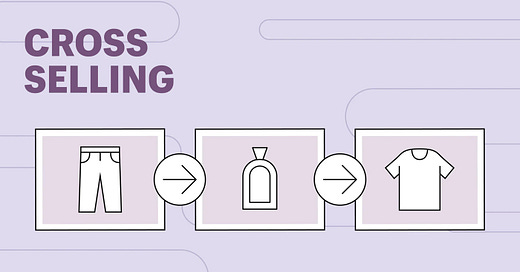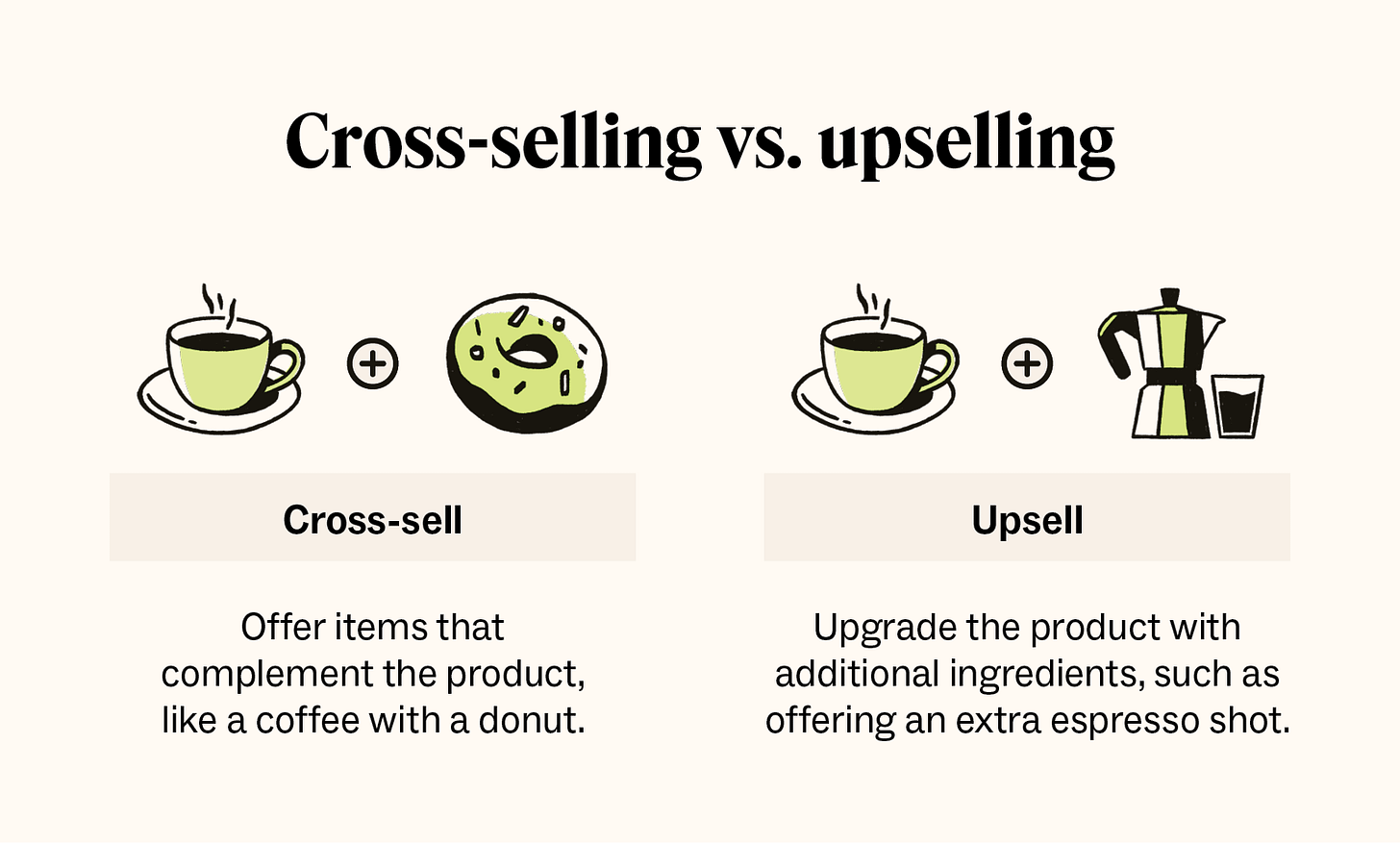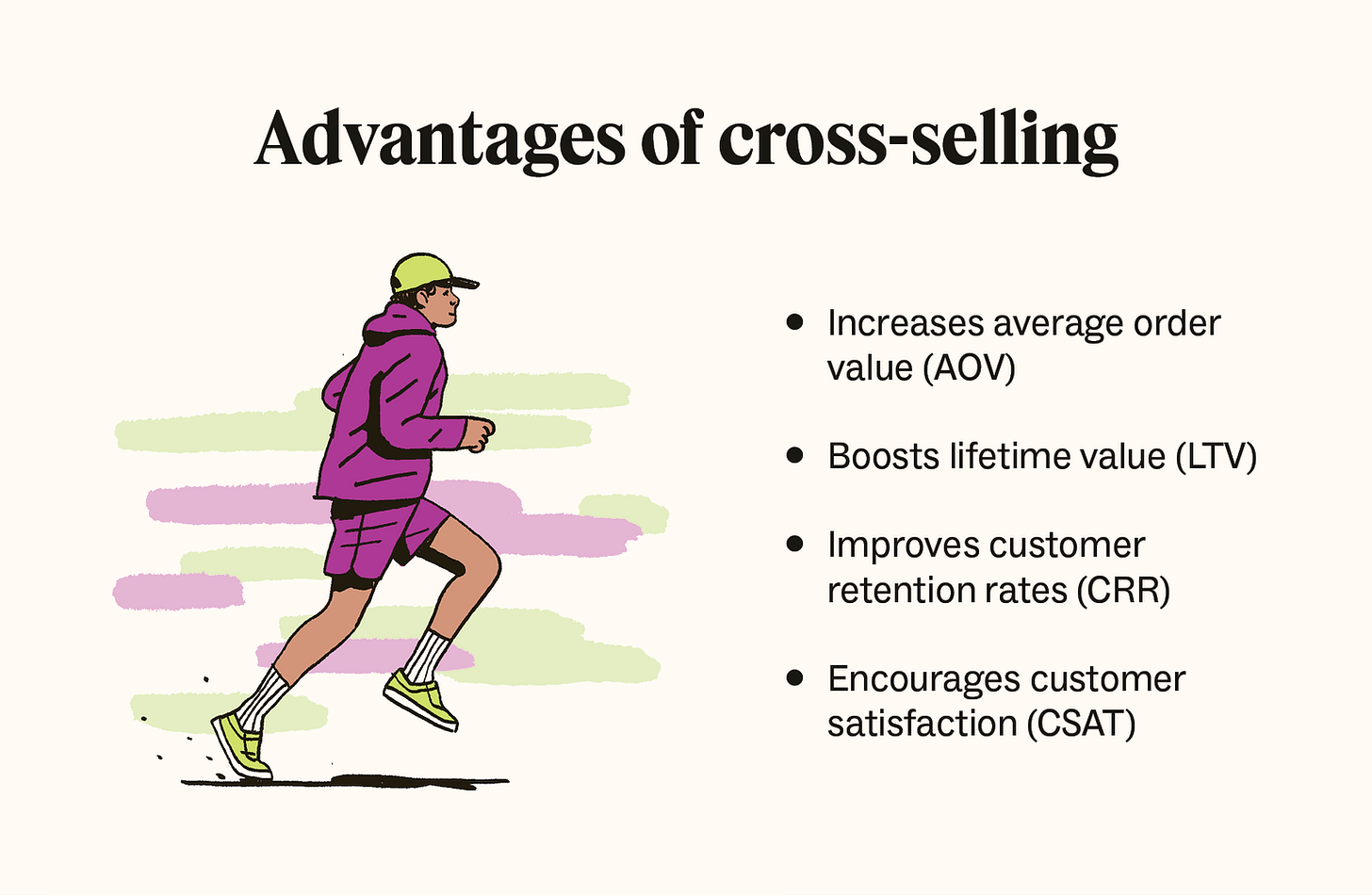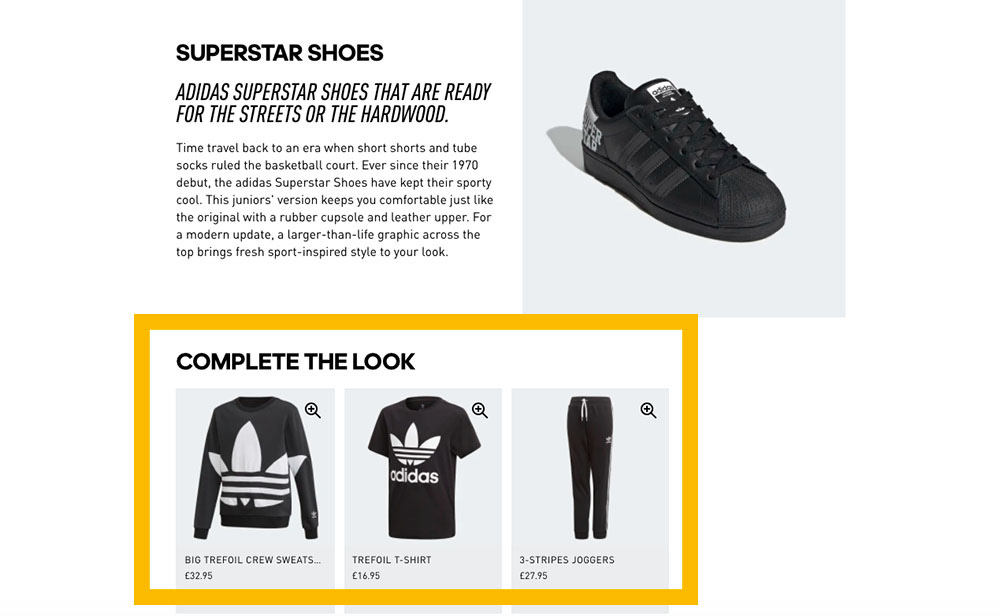How to Identify Cross-Selling Opportunities in the User Journey?
And unlock more revenue for your business.
In my professional experience, the strategic implementation of cross-selling has proven to be a game-changer for business growth and customer engagement. It's a nuanced art that, when executed with precision, significantly elevates both revenue and customer satisfaction.
In this article, I will share ways to identify where you can potentially place cross-selling options, how to measure it, and how to make it work.
What is the difference between cross-selling vs. upselling?
Before we deep dive into cross-selling, its important to clear this out of the way, as see from experience that it can be easily confused.
They say a picture speak a thousand words, so lets to that more visual.
What cross-selling is and its benefits for your business?
Imagine boosting your revenue without acquiring new customers. That's the magic of cross-selling, the art of suggesting complementary products to existing customers. Not only does it increase average order value and overall sales, but it also strengthens customer relationships by providing solutions tailored to their needs.
The Psychology Behind Cross-Selling: Cross-selling leverages the psychological principle of commitment and consistency. Customers who have already decided to make a purchase are more likely to consider additional, related products. This is because they want their actions (buying additional items) to be consistent with their commitment (the initial purchase).
For instance, a fashion retailer suggesting a belt when a customer purchases trousers is an excellent example of cross-selling. Similarly, a SaaS company offering a premium feature upgrade during a software trial can significantly increase the perceived value of their service.
Quantifying the Benefits: Studies and case studies have shown that effective cross-selling strategies can increase revenue by up to 30% and improve customer satisfaction and loyalty. This is because customers feel understood and valued when offers are personalized and relevant.
Why its important to understand the user journey to identifying cross-selling opportunities?
Identifying Needs and Pain Points: By mapping the user journey, you gain invaluable insights into the challenges and needs at each stage, enabling you to tailor your cross-selling strategies with precision.
Pinpointing Opportune Moments: Each phase of the journey, from awareness to consideration and purchase, presents unique opportunities for cross-selling. Recognizing these moments allows you to introduce complementary products when your customers are most receptive.
Deepening Personalization and Relevance: The more you understand the journey, the better you can personalize your cross-selling efforts, ensuring that each suggestion resonates deeply with the customer's current needs and preferences.
Driving Higher Conversion Rates and Revenue: Effective cross-selling strategies, rooted in a thorough understanding of the user journey, lead to higher conversion rates and boost your bottom line.
Strategies for Identifying Cross-Selling Opportunities
1. Extensive mapping of your user journey
Understanding the user journey is fundamental to any successful cross-selling strategy. This journey, essentially a roadmap a customer follows from first becoming aware of your brand to making a purchase and beyond, is divided into several key stages:
Awareness: The customer discovers your brand and products for the first time.
Consideration: The customer thinks about purchasing your product, comparing it with others.
Decision: The customer decides to purchase.
Retention: The customer’s post-purchase experience, which influences their loyalty and repeat purchases.
Recognizing these stages allows us to see the customer's journey not just as a path to sale but as an opportunity to enhance their experience with relevant offers.
How each stage represent different opportunities for cross-selling?
Awareness Stage: Here, cross-selling is about introducing complementary products or services that enhance the initial interest. For example, if a customer is exploring fitness trackers on your website, this is the time to highlight related fitness gear like water bottles or workout apparel.
Consideration Stage: Customers are comparing options, making it ripe for showcasing the added value of bundling or purchasing complementary products. If they're considering a laptop, suggesting a bundle that includes a carrying case and mouse can be appealing.
Decision Stage: At this point, the customer is ready to buy. Cross-selling can involve suggesting products that customers frequently buy together, like offering screen protectors or insurance plans for electronic devices at checkout.
Retention Stage: After the purchase, cross-selling focuses on products that enhance the user's experience with the purchased item, or that are aligned with their purchase history and preferences. If they've bought a coffee machine, now might be the time to suggest gourmet coffee beans or descaling solution.
2. Data-driven identification
To unlock the full potential of cross-selling, turning to data is like finding a compass that points directly to where treasure lies. This data comes from various sources, each offering unique insights into customer preferences and behaviors:
Exploring different data sources
Purchase History: Like a diary of customer choices, purchase history reveals what customers have bought in the past, indicating what they might be interested in next. Leverage your data / engineering teams to build an ML model to be to predict that with some accuracy.
Behavioural Data: This includes how customers interact with your website or app ( what they browse, how long they spend on certain pages, and what they add to their wishlist or cart without purchasing ).
Customer Feedback: Direct input from customers through surveys, reviews, or customer service interactions. This feedback can highlight what customers appreciate and what additional needs they might have.
Analyzing specific data points for cross-selling insights
Frequently Bought Together: This is a classic indicator for cross-selling. If customers often buy product A and product B together, new customers buying product A might appreciate a prompt for product B.
Product Page Views and Time Spent: If a customer spends a lot of time viewing specific products but doesn't purchase them, they might still be interested in these items. This interest can be a cue for a cross-sell, especially if you can offer a deal or bundle.
Repeat Purchases: Customers who frequently purchase certain items may benefit from complementary products. For example, someone regularly buying specialty coffee might be interested in a high-quality coffee grinder.
Customer Service Inquiries: Sometimes, the questions customers ask provide direct insights into their needs. If customers frequently ask about accessories for a product, highlighting these accessories as cross-sell items can meet their needs effectively.
Adidas is a great example here with their “complete the outfit” recommendation engine that suggest full dress up. This don`t happen at the checkout, but within the landing page as part of the customer journey.
3. Personalization & Customer Engagement
Personalization and engagement are the cornerstones of a successful cross-selling strategy. By tailoring your approach to fit the individual needs and preferences of your customers, you can significantly enhance their shopping experience. Let's break this down further:
Crafting personalized recommendations
Leveraging Customer Profiles: Use what you know about your customers, from demographic information to past interactions, to tailor your cross-selling suggestions. For instance, if a customer has shown a preference for eco-friendly products, highlight green alternatives as cross-sell options.
Behavior-Based Suggestions: Analyze browsing and purchase behaviors to offer products that align with the customer's interests. For example, if someone frequently purchases science fiction novels, suggest newly released books in that genre.
Enhancing engagement through multiple touchpoints
Email Campaigns: Send personalized emails based on customer behavior. For instance, after a customer purchases a new phone, an email highlighting compatible accessories like cases or earbuds can be an effective cross-sell.
On-site Recommendations: Implement dynamic widgets on your website that display related products or accessories based on what the customer is currently viewing. This real-time personalization can significantly increase the likelihood of a cross-sale.
After-Sale Follow-ups: Contacting customers after a purchase to thank them and suggest additional items based on their purchase history can not only drive cross-sales but also boost customer loyalty.
Creating a feedback loop
Customer Reviews and Surveys: Encourage customers to leave feedback on their purchases and use this data to improve product recommendations. If customers frequently praise a particular product feature, consider cross-selling products with similar features.
Analytics and Performance Tracking: Use analytics tools to monitor the success of your cross-selling initiatives. Track metrics like conversion rates and average order value to understand what works and what doesn’t. This data can inform future personalization efforts.
As a conclusion, I would say that, crafting a nuanced cross-selling approach transforms the art of recommendation into a strategic engine for growth, intertwining customer insights with bespoke engagements.
It's not just about suggesting more products; it's about curating experiences that resonate, fostering deeper connections with each interaction. Don`t underestimate this revenue lever!






